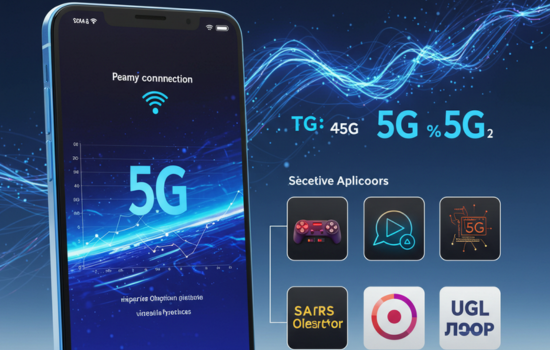Advertisements
5G technology is revolutionizing mobile connectivity, offering ultra-fast browsing speeds and lower latency.
However, many users still don't know how to activate 5G on their devices. In this article, we'll explain how to enable 5G on your phone, which devices are compatible, and how to get the most out of this network.
Advertisements
1. What is 5G and why should you activate it?
5G is the fifth generation of mobile networks, designed to offer greater speed, stability, and efficiency for internet connections. Compared to 4G, 5G enables faster downloads, faster response times for online gaming, and a better HD video streaming experience.
By activating 5G on your cell phone, you can enjoy benefits such as:
- Speeds up to 100 times faster than 4G
- More stable connection in areas with high user density
- Lower latency for seamless online gaming and video calls
- Greater energy efficiency in compatible devices
- Better connectivity in urban environments and mass events
See also
- Free WiFi Without Complications: Save Data and Browse Without Limits
- Mobile phone full? Complete guide to free up space now
- Automotive Mechanics App
- Dark Channel Apps
- Domino Online Apps
Advertisements
5G is also critical to the development of emerging technologies such as the Internet of Things (IoT), augmented reality, and artificial intelligence. Thanks to its low latency and high data transmission capacity, it enables improved communication between smart devices.
2. Is your phone compatible with 5G?
Before activating 5G, you need to make sure your phone is compatible with this technology. To check, follow these steps:
- Check your device specifications: You can check the manufacturer's website or the phone box to see if it supports 5G.
- Check system settings:
- In Android: Go to Configuration > Networks and Internet > Mobile network and look for the 5G option.
- In iPhone: Access to Configuration > Mobile data > Options > Voice and data and check if 5G is available.
- Make sure your mobile operator offers 5G coverage in your area: Not all countries and cities have 5G networks available, so check with your mobile service provider.
Some recent phone models already include 5G support, but not all devices can access all frequency bands. 5G support may vary depending on the region and mobile operator. Additionally, some cheaper phone models may have limited hardware that prevents them from taking full advantage of 5G technology.
3. How to activate 5G on your cell phone
If your device is compatible and your carrier has 5G coverage, follow these steps to activate it:
In Android
- Open Configuration on your phone.
- Go to Networks and Internet either Connections.
- Select Mobile network.
- Click on Preferred network type and choose 5G/4G/3G/2G (automatic).
- Restart your phone if necessary to apply the changes.
In iPhone
- Open Configuration.
- Go to Mobile data and select Options.
- Click on Voice and data.
- Select one of the following options:
- 5G Auto: Turn on 5G only when necessary to save battery life.
- 5G Activated: Always use 5G when available.
- LTE: Keep 4G usage if you want to conserve battery.
- Restart your device if you don't see the 5G icon in the status bar.
Additionally, in some cases, you may need to update your mobile operator settings. To do so, go to Configuration > General > InformationIf an update is available, you'll receive a notification to update your carrier settings.
4. What to do if 5G doesn't work on your phone?
If you don't see a signal on your phone after turning on 5G, try these methods:
- Check the coverage: Use your carrier's app or check their website to make sure 5G is available in your location.
- Update the operating system: Make sure your phone has the latest version of Android or iOS.
- Change the SIM cardSome older SIM cards aren't compatible with 5G. Check with your carrier if you need a replacement.
- Activate data roamingIn some countries and operators, 5G only works with roaming enabled.
- Reset network settings: Enter to Configuration > System > Restore > Reset network settings to resolve possible connection errors.
- Contact your operator: Ask if your data plan includes 5G access, as some plans require additional activation.
If you still don't have a 5G connection after completing these steps, it could be due to carrier restrictions on your data plan or compatibility issues with the frequency bands used in your country.
5. Advantages and disadvantages of 5G
While 5G brings many improvements, it also has some limitations that are important to consider:
Advantages
✅ Faster connection speed. ✅ Lower latency in games and video calls. ✅ Greater capacity for multiple connected devices. ✅ Optimized for IoT and emerging technologies.
Disadvantages
❌ Higher battery consumption compared to 4G. ❌ Limited availability in some regions. ❌ Requires compatible phones and plans. ❌ May be less stable indoors due to higher frequency coverage.

6. Conclusion
Activating 5G on your phone can significantly improve your browsing experience, offering greater speed and stability. Make sure your device is compatible, check your carrier's coverage, and follow the appropriate steps to enjoy this technology. If you have any issues with activation, please contact your mobile service provider for assistance.
5G is the future of mobile connectivity, and while it's still expanding, its adoption will bring significant benefits in a variety of areas, from entertainment to productivity. Take full advantage of 5G connectivity and experience the new era of mobile internet!






